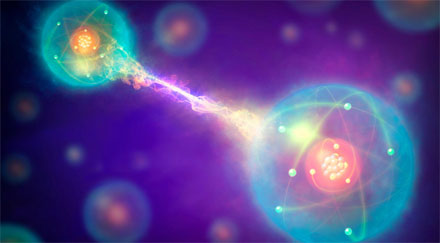University of Arizona (UA) researchers are building a shared research and training instrument to help scientists in diverse fields benefit from quantum resources, including those with no expertise in quantum information science. Professor Zheshen Zhang is leading the construction of the Interdisciplinary Quantum Information Research and Engineering instrument, known as Inquire.
Inquire’s aim is to facilitate the cross-discipline use of entangled photons for research purposes. Construction on the project has begun and the expected completion date is September 2021.
The project has received approximately $1.4 million in funding from the the National Science Foundation (NSF) and UA.

Conceptual artwork of a pair of entangled quantum particles interacting. Courtesy of Mark Garlick/Science Photo Library.
Zhang and his co-investigators are building a facility that will create quantum-entangled photons, then deliver them via fiber optics from the UA Electrical and Computer Engineering Building to four other buildings on campus. Researchers can send their photons into the core facility to be imaged by the high-tech microscopes, and the core facility can share entangled photons with labs across campus.
Inquire will enable researchers to obtain information from individual photons to aid in their work. For example, a biomedical engineering lab could be doing an imaging study on a protein or an organic molecule that’s emitting a signal too weak for traditional cameras to see. “You can send your photons to the core facility, which is equipped with an array of ultrasensitive cameras that can see things at the single photon level,” Zhang said.
Using entangled photons as an illumination source can provide higher sensitivity, less illuminating power, and the same or higher resolution than high-powered lasers, which can damage samples. “Two entangled photons can be worth a million of their classical brethren, potentially allowing us to image deeper without harming tissue,” said professor Jennifer Barton, a collaborator on the project.
Researchers can also use entangled pairs of photons as probes to help determine the nature of unidentified materials. The changes a material introduces to a photon, such as a change in color, provide clues to the material’s identity. When one entangled photon in a pair is used as a probe, the material introduces changes to both photons in the pair.
“Now you can perform a measurement on both photons to learn about the sample being probed,” Zhang said. “You can have twice as much information about the way the material is affecting the photon.” Entangled photons can also be used in quantum communication.